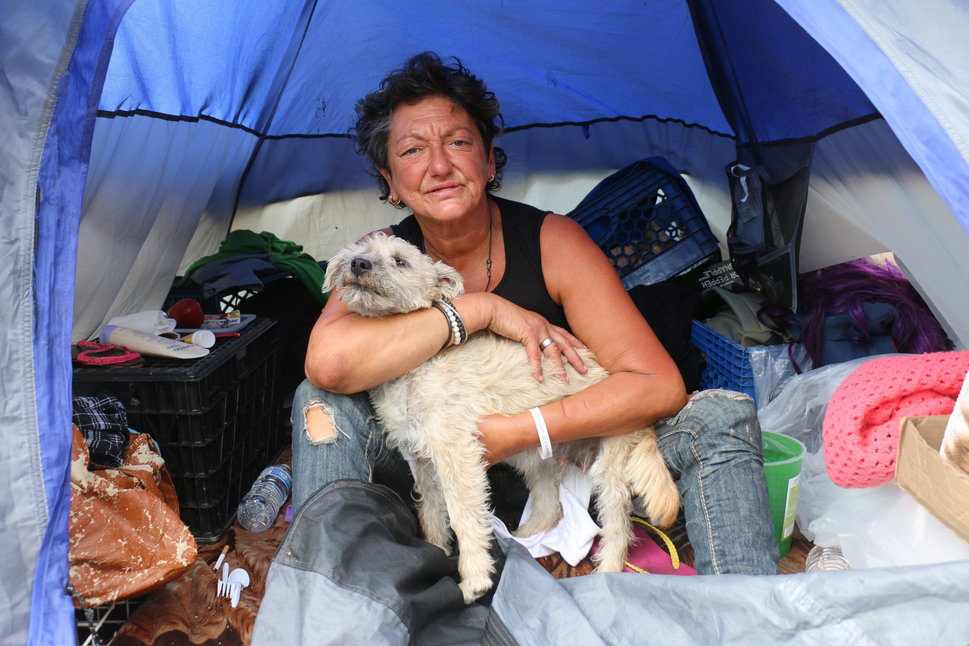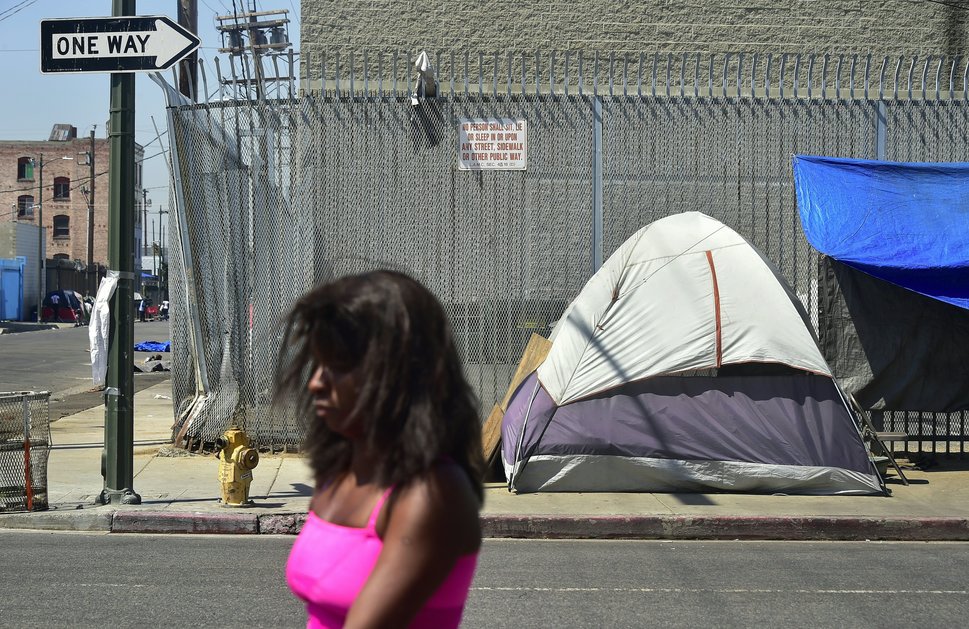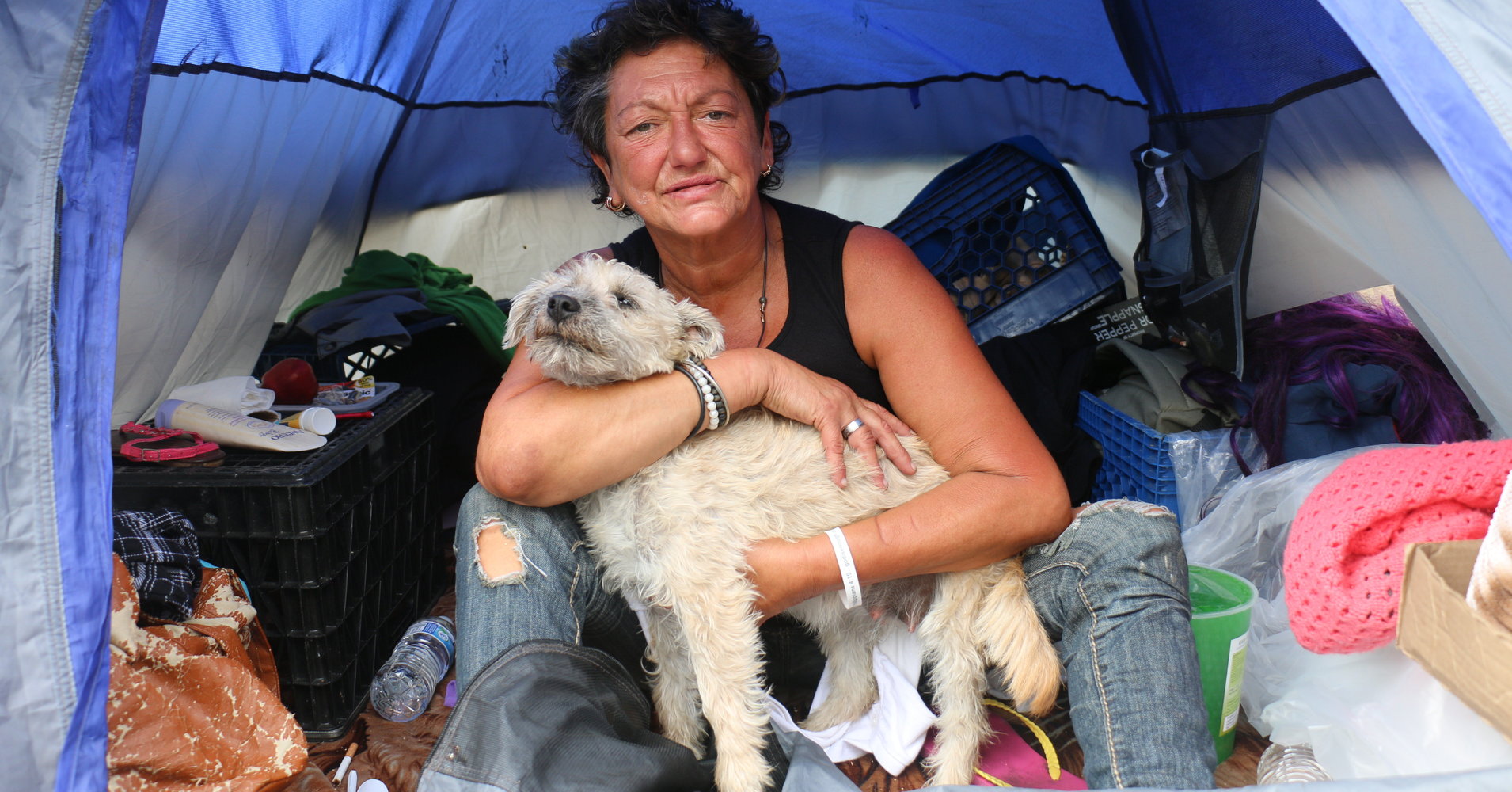[ad_1]
LOS ANGELES ― Every time Graciela Fernandez gets off the bus at Skid Row, she clutches her industrial-grade, cross-body bag with thick straps. She checks the road in both directions and scans for danger. Carefully, she makes her way down the street she called home until just three months ago.
Fernandez first arrived at Skid Row early one morning in July 2015, wearing nothing but a tank top, her underwear and ripped sneakers. She’d fled an abusive boyfriend who, she says, had threatened her with a knife and trapped her in a remote house for days. At 4:00 that July morning, she searched the line of colorful tents for Connie Revoiro. Fernandez had met Revoiro, who goes by the name “Mama Cuba,” on a scouting trip to the area three weeks before. Now Mama Cuba was her only hope.
“I searched from tent to tent to tent until I found her,” Fernandez said one day this past October. “It was awful. I didn’t come out of Mama Cuba’s tent for three or four days. I was terrified. Wherever she would go, I was there, because I was so scared.”
Nearly three years later, Fernandez is still frightened by Skid Row. She’s had her purse stolen more times than she can count. Once, a man yelling vulgar things followed her and grabbed her by the arm. She beat him with a wooden stick until he let go.
The number of homeless people in Los Angeles County went up more than 23 percent last year, according to the annual homeless count. Nearly 58,000 people were living on the street at the time of the count, about 4,500 of them in the Skid Row area ― a four-mile stretch of downtown Los Angeles often dubbed “the homeless capital of America.”
Women account for a third of people experiencing homelessness in L.A. As women like Graciela Fernandez and Mama Cuba navigate the challenges of living in a community where drug use, mental illness and assault are prevalent, they are particularly vulnerable to violence, predators and abuse. Amid a lack of shelter beds and resources to help them cope, loosely formed networks of women have banded together to fill the unmet needs. Some have found support in each other as they unite to survive and to demand solutions.
Skid Row is a meeting place for L.A.’s homeless community. Its streets are lined with tents, sleeping bags and suitcases and carts filled with prized possessions. Clusters of tents and makeshift structures have turned into quasi-separate neighborhoods, where people play cards, visit each other’s pets and barter for items like toilet paper and nail polish.
“The street is the street,” Mama Cuba said one day last fall, flashing a toothless, red-lipsticked grin. “It’s hard to live in the streets. There’s a lot of fights. Everything could be fine. It could be fine for a second, and all of the sudden everything jumps.”
Mama Cuba has many adopted Skid Row “daughters,” women like Fernandez who look to her for support in their darkest times. “If they’re hungry, they come to me. That’s why they call me Mama Cuba,” she said. “If there’s an extra blanket, not even extra, I give my own, I’m giving my last, I don’t really care.”
Yet Skid Row friendships can be difficult, complicated by mental illness, substance abuse and the daily struggle for survival. Today, Fernandez’s feelings for Mama Cuba swing between gratitude and betrayal. She knows how much Mama Cuba did to help her in her time of need, but she says Mama Cuba’s drug addiction and mental health problems have led her to steal from her multiple times ― a charge Mama Cuba vehemently denies.
Mental illness and substance abuse
Mental illness and drug addiction are major challenges in Skid Row that contribute to the vulnerable position of some of the women.
“Sexual assault and sexual harassment are everywhere,” said Angelia Harper, who goes by the name “Big Momma of Skid Row.”
After escaping homelessness herself, Harper has spent the last 20 years walking around the area by night in an effort to increase safety and help women get the resources they need, especially after an assault. More than 90 percent of the women in Skid Row have experienced physical or sexual violence in their lives, according to a 2016 assessment carried out by the Downtown Women’s Center, an L.A. nonprofit.
Compounding the problem, and the trauma, Big Momma explained, is that many perpetrators go free. “A lot of them are still looking at their abuser or the person that perpetrated the crime against them,” Big Momma said of the women she works with.
Some women fear reporting crimes to law enforcement because they believe they’ll risk retaliation. Others are hesitant to engage with police, for any number of reasons. Some are undocumented; some are on probation or parole; others struggle with substance abuse or have had negative experiences with law enforcement in the past. Even if a woman does report her assault and the perpetrator is arrested, it’s not uncommon for them to get released the same day.

Shelters aren’t always a safe haven
The longer women are homeless, the harder the climb back to stability becomes. But while many women are eager to escape the violence of the streets, their options are scarce. “There are no other avenues out,” Big Momma said.
There are a number of social services, shelters and nonprofit organizations in Skid Row, but the needs of the neighborhood’s population far outweigh the available resources.
There are only two overnight emergency shelters that serve single women in Skid Row, with 90 beds at the Midnight Mission and 168 beds at Union Rescue Mission. Both organizations have been providing shelter to the area’s homeless since the early 20th century, but it wasn’t until this past June that the Midnight Mission opened its doors to women who needed overnight housing. Before, the shelter only served homeless men.
Because space is limited, women who arrive at the shelters are first assessed by case managers. Their individual circumstances determine whether they get priority for a bed that night, how long they can stay and what other resources they are eligible for.
Big Momma is frustrated by the lack of shelter services available to women, particularly for victims of domestic violence and sexual assault. “Once a shelter is full, it’s full. There’s nothing else in place,” she said.
The current shelter system also fails single women for reasons that go beyond scale.
Through her experience helping trauma victims, Big Momma has learned that many of them, particularly those who have lost children, don’t feel comfortable staying in shelters designed for women and children. “They don’t want to be around these kids. They don’t want to have reminders that they were once this woman, that everything was great in their lives until this happened to them,” she said.
The emergency shelters that are available for single women aren’t necessarily safe or welcoming environments. In the DWC’s 2016 survey of women in certain L.A. neighborhoods, including Skid Row, nearly one-third of the women who slept in emergency shelters or transitional housing reported feeling unsafe. Women have complained about disrespectful staff, violent incidents and traumatic experiences.
Linda Sanders, a registered nurse, moved into Union Rescue Mission’s emergency shelter after her husband’s gambling addiction led him into crippling debt, which resulted in the loss of the couple’s home. She described a chaotic, unsanitary environment where she often felt unsafe.
“I’d say at least 80 percent [of the women at URM] have mental illnesses,” she said. “Some were previously incarcerated. Some are drug addicts. They’re very loud and they just wake up irate.”
Alexandra Monsibaez, URM’s public relations coordinator, said it can be challenging when so many women are living together in a confined space.
“We try our best to keep it as safe as possible for everyone,” Monsibaez said. “Sending women back out into the street if they are suffering from addiction or mental health issues can exacerbate those problems.”
According to DWC’s 2016 survey, 50 percent of homeless women in the area have mental health issues and 28 percent are recovering addicts.
“We’re doing the best that we can with the resources that we have, but we’re overwhelmed with the size of the problem,” URM chief executive Andy Bales said. “We have a policy of never turning away a woman in need, because there are sexual predators out on the streets.”
URM has an enclosed space where women who aren’t able to get a bed can spend the night on a mattress on the floor. The organization is working to construct a permanent dome-shaped structure that is expected to shelter 137 more women.

‘We need to get together’
The women in Skid Row need shelters that protect them, more access to affordable housing and a guarantee that their abusers won’t be free to retaliate against them. But until that happens, women band together in order to survive.
With the help of her new partner, Graciela Fernandez recently secured a studio apartment miles away from the noise and commotion of Skid Row. But Fernandez still returns every weekend to cook for her old neighbors in the area’s “Cuban Barrio.” “I can’t just forget them. These people were my family,” she said.
Fernandez and Mama Cuba have set aside their differences. “She did betray me, but she learned from that experience and how much it hurt me,” Fernandez said. “I love her to death. I’d never leave her behind.”
This story is part of the series Homeless on the Streets of L.A., a four-month investigation by students at USC Annenberg’s Reporting on the Homeless class. The project, overseen by veteran journalists Mary Murphy and Sandy Tolan, continues through early 2019. Contact [email protected] or [email protected] for more info.
[ad_2]
Source link

